

On the Balkan peninsula, there lies a welcoming nation called Bosnia and Herzegovina.
It was once a part of Yugoslavia but earned independence in 1992. It is now home to several historical sites and landmarks that serve as reminders of the region's past as a Yugoslav province.
Croatia to the north, west, and southwest; Serbia to the east; and Montenegro to the southeast all share boundaries with Bosnia and Herzegovina.
It has two distinct regions: one that is primarily hilly, which is why it has previously hosted the winter Olympic games, and another that has access to a small stretch of the Adriatic Sea shoreline in the south. In other words, it essentially has the best of both worlds.
Generally speaking, Bosnia and Herzegovina is a secure nation. Tourists shouldn't have any more issues in this nation because its citizens are incredibly nice and eager to assist. Small communities rarely experience significant crimes. With numerous attractions and things to do, here are why you should visit and enjoy Bosnia and Herzegovina!


Image Credit: john mcsporran from Trossachs, Scotland, CC BY 2.0, via Wikimedia Commons
The sequence of waterfalls at Kravice is located in a natural reserve southwest of the city of Mostar in Bosnia and Herzegovina, plunging down cliffs as high as 83 feet into a natural, aqueous amphitheater that is approximately 500 feet broad.
The overall image is of a smaller, more approachable sibling to the famous Iguazu Falls, which span the border between Argentina and Brazil. This smaller sibling is still relatively unexplored and unspoiled, something its larger sibling can no longer claim.
You can hire tour guides to take you to Kravice Falls, but the beauty of the location lies in its general lack of tourists, so going there with a big group of strangers can be counterproductive.
Instead, knowledgeable tourists advise hiring a car from Mostar or bartering for a cab to take you to and from the forests, the latter of which just ups the adventure factor by including the excitement of price haggling. The site is a must-visit for all Bosnian tourists.

Image Credit: ARK D-0 Tito's Nuclear Bunker
The nuclear bunker formally known as ARK (Atomska Ratna Komanda, Atomic War Command) D-0 was created at the direction of Yugoslav revolutionary and "benevolent dictator," Josip Tito.
The building began in March 1953 and wasn't complete until September 1979, 26 years later. At its deepest point, it extends 663 feet into the mountain, and over 919 feet of granite are on top of it.
It is all concealed beneath what appears to be an average house. The entire building is shaped like a horseshoe and contains offices, meeting rooms, dorms, and of course, Tito's private quarters.
The efforts made to keep this facility a secret demonstrate the significance of the project. For starters, all workers were blindfolded before being brought to the construction site and were only permitted to take them off inside.
Only 16 people were aware of the bunker's existence in September 1979, when construction was completed — 13 soldiers working at the site and three generals. They had all sworn to protect the location's secrecy. Visiting this location lets you in on true Bosnian history.

Image Credit: Milan Suvajac, CC BY 4.0, via Wikimedia Commons
Bascarsija is the Stari Grad (Old Town) of Sarajevo's old Oriental bazaar, whose hammams (baths) and mosques date all the way back to 1462.
The Gazi Husrev-beg Mosque, which has the name of a Turkish governor of Bosnia and Herzegovina, was constructed in 1530 in Ottoman style by the Persian architect Adem Esir Ali, and is the most significant and impressive of Bascarsija's mosques.
The mosque, which was once a complex of prayer halls, a madrasa (Quranic school), a medieval soup kitchen for the poor Muslim population, a restroom, and a library, was severely damaged during the Balkan wars of the 1990s but has since undergone extensive reconstruction.
Today, its distinctive dome once again serves as the center of Bascarsija, and its spiky minaret is a landmark visible from all over Sarajevo.